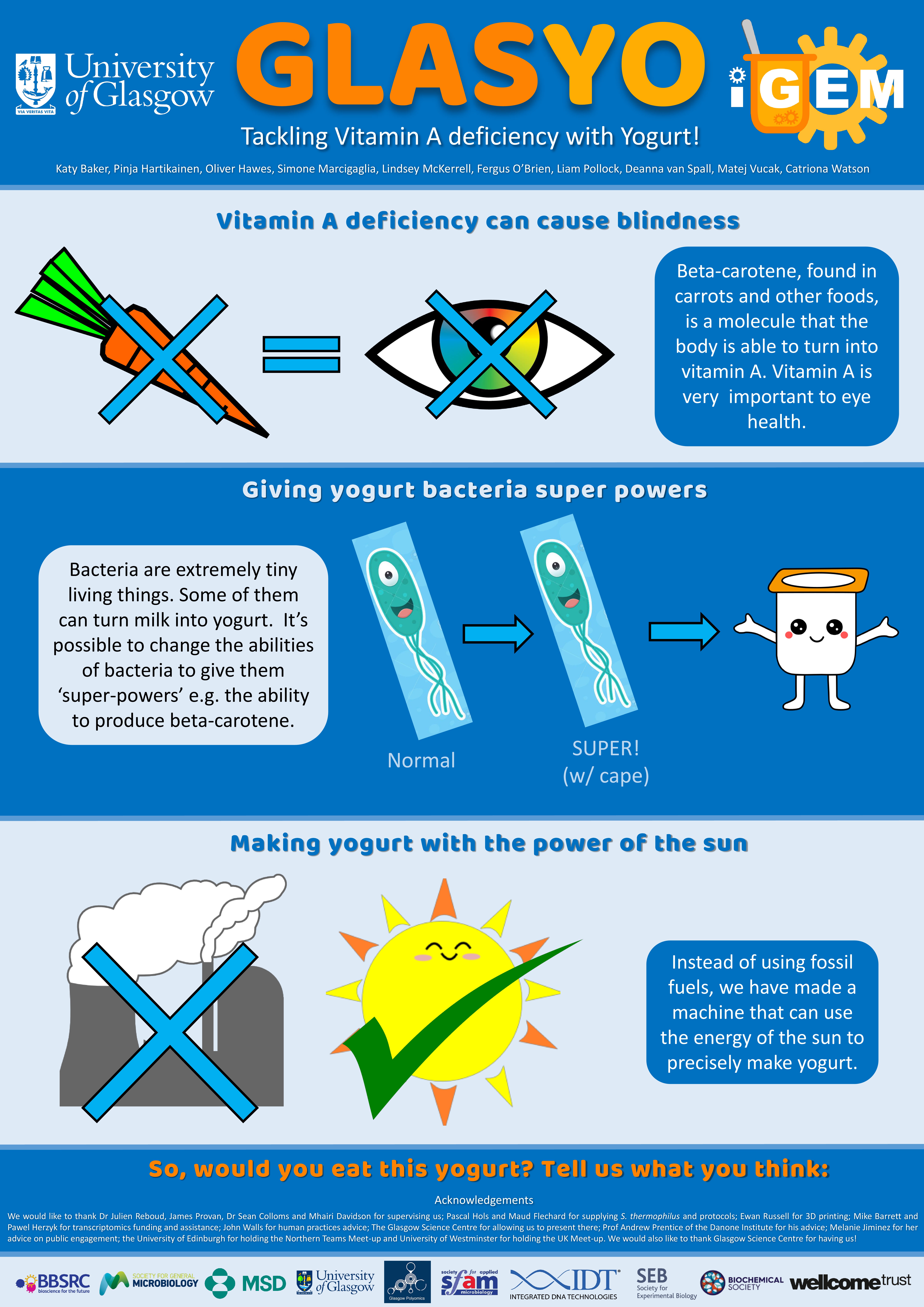Contents
SIM device
Our approach to the integration of human practices has been highly collaborative. Through private conversations within the team, and with friends and family, we recognised early on that there was a potential concern with the acceptance of our project to end-users. As we aim to create a yogurt that will contain genetically-engineered bacteria, said modified bacteria would be ingested, which could cause many fears and concerns with the public. We thus decided to seek the advice of experts in social science and food for developing world settings.
Consulting experts - John Walls
Dr. John Walls is a researcher in social science, specialising in the public perception of synthetic biology and genetically modified organisms at the University of Glasgow [1]. When we pitched our project to him, he indicated that people may be uncomfortable with the idea of synthetic organisms being able to grow in their gut. As our product would aim to use common yogurt bacteria - found in both home culture and commercial yogurts - they would be highly likely to grow in the gut [2]. After brainstorming, we collaboratively came up with ‘[The SIM device]’ - a self-inactivating mechanism that would inactivate our synthetic bacteria upon departure from the yogurt.
We based our SIM device on a ‘toxin-antitoxin’ natural mechanism in bacteria which we could manipulate . Such a system also negates the use of antibiotics for selection. We felt that this would increase public confidence in our project. To confirm this, we made this a central piece of our public engagement activities.
The Glasgow Science centre
On the 8th and 9th of October 2016, we had the opportunity to present at the Glasgow Science Centre as part of their “Meet the Experts” event. The visitors during the events were mostly families with young children, so our aim was to present our project in a fun and engaging way that would allow people of all ages to understand our goals. We designed easy to read posters, an animation movie and a game for these sessions, with the goal of making our project more accessible.
We wanted to introduce the idea of vitamin A being important to eyesight as well as incorporate bacteria engineering and yogurt production. This entailed having a yogurt pot as a target and ping pong balls representing bacteria. We asked people to throw as many ping pong balls as possible into our yogurt pot, firstly with their eyes open and then with their eyes closed. Comparing the scores, it was evident that having their eyes closed resulted in lower scores relative to having their eyes open, as you would expect. We told them that the more bacteria they managed to get into the yogurt pot, the more nutritious it would be.
After finishing the game, we explained that the aim of our project was to prevent vitamin A deficiency in low-resource settings by providing enriched yogurt. We described how we had designed synthetic bacteria to produce β-carotene, the precursor to vitamin A. We then asked the public about their opinions on GMOs in general and also with regards to our project.
Initially we were slightly hesitant about the response we would receive from the public. We suspected that there would be many misconceptions about GMOs and synthetic biology, especially considering the recent law passed by the Scottish Government detailing that growing GM crops would be illegal for the foreseeable future. However, we were impressed with the level of interest in our project together with the positive feedback we received.
Interestingly, the issue most people had with our project was the potential orange colour due to β-carotene production. This issue with the colour of our yogurt may be unique to the UK as in other countries yogurt with fruit flavouring are often artificially coloured. Some of the more controversial issues such as synthetic bacteria growing in the gut did not seem to cause much hesitation, possibly due to our work in counteracting misconceptions and work on the SIM device.
We do appreciate that people who visit the Glasgow Science Centre would potentially be more open minded about GMOs and perhaps have an understanding of synthetic biology prior to their visit. This may have resulted in an inaccurate representation of public opinion around this area, so ideally it would have been good to spend more time to speak to a larger representation of the public to gain further understanding.
In summary, through team consultation we thought that the public at large would have many concerns about ingesting GMOs. After consulting experts, we integrated their advice into our project to add the SIM device. We then wanted to confirm our suspicions but got a surprising and much more positive outcome than we were expecting during public engagement. We do not however have the data to say whether this is because of the development of our SIM device or if the sample of the public we engaged with does not have much of an issue with GMOs. With this integration of the SIM device into our project we aimed to alleviate many fears around ingesting GMOs however more large scale educational work needs to be done to change some of the opinions surrounding synthetic biology.
References
- ↑ Horlick-Jones, T., Walls, J., Rowe, G., Pidgeon, N., Poortinga, W., and O'Riordan, T. (2006) On evaluating the GM Nation? Public debate about the commercialisation of transgenic crops in Britain. New Genetics and Society, 25(3), pp. 265-288.
- ↑ Bezkorovainy, A. (2001). Probiotics: determinants of survival and growth in the gut. Am J Clin Nutr 73, 399S-405S.




